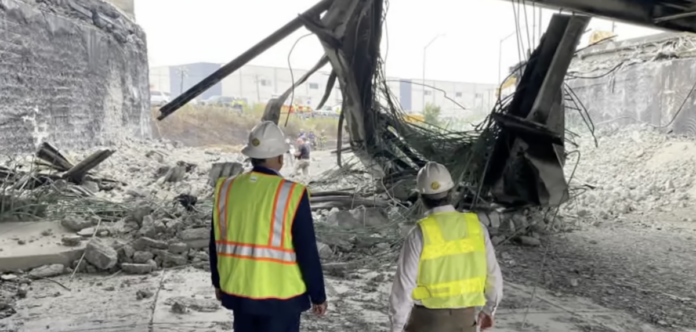On Wednesday, June 14, Pennsylvania Governor Josh Shapiro unveiled the plans to restore traffic flow on the fire-damaged section of Interstate 95 in Philadelphia. The primary objective was to fill the gap left by the collapsed bridge and create three lanes in each direction by repaving over the fill. Additionally, new spans would be constructed on either side of the temporary lanes. The announcement was made during a press conference attended by federal, state, and local officials, as well as members of the local construction union.
Although Governor Shapiro did not provide a specific timeline or cost estimate for the project, he emphasized that it would be completed as quickly and safely as possible. The federal government had committed funds to cover the expenses. The demolition of the damaged southbound lanes was scheduled to be completed by Thursday, June 15. The project would then proceed by filling the gap under the interstate with recycled glass aggregate, with the first loads arriving the following day. Work would continue around the clock until the project’s completion.
To facilitate the construction, a 35-foot space on either side of the temporary lanes would be allocated for building a replacement bridge. Once the new spans were ready, the fill beneath them would be removed and repurposed for another project, according to State Transportation Secretary Mike Carroll. The chosen approach aimed to swiftly and safely reopen the interstate, and a live webcam would stream the construction work at the site continuously.
Transportation Secretary Pete Buttigieg, who visited the scene of the crash and bridge collapse, emphasized the significance of Interstate 95 and its restoration for the transportation network. In coordination with transportation officials from neighboring states such as New York, New Jersey, Delaware, and Maryland, Pennsylvania aimed to ensure that motorists bound for the state were aware of the construction and detours in place.
At the end of the day, there’s no substitute for I-95 to being up and running in full working condition,” he said.
In addition to the plans for reconstruction, Transportation Secretary Pete Buttigieg raised concerns about the impact of the bridge collapse and subsequent traffic disruption on the cost of transported goods along Interstate 95. He warned of potential “upward pressure” on prices due to the interruption of traffic flow.
According to estimates by the American Trucking Association, around 14,000 trucks typically traverse the damaged bridge daily. With the bridge out of commission, these trucks are now forced to take non-interstate detours spanning approximately 40 miles, which include navigating through approximately 60 traffic lights.
On Tuesday evening, the Philadelphia Medical Examiner’s Office provided details regarding the cause of death of Nathan Moody. The office determined that Moody, aged 53, died due to blunt trauma to the head, inhalation, and thermal injuries. The manner of death was ruled as an accident. Moody’s family stated that he had been working as a driver for approximately 10 years.





